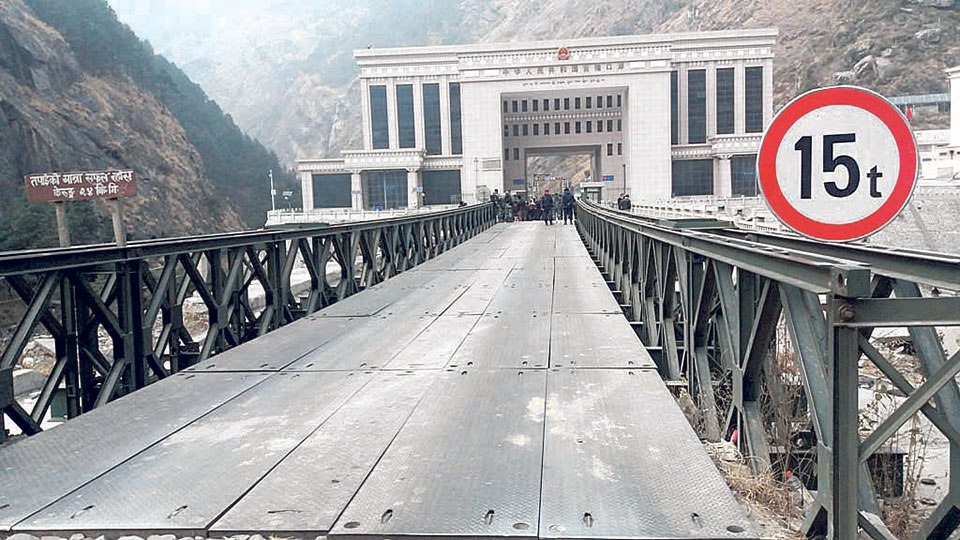
OR
Nepal-China trade hit by coronavirus threat
Published On: February 18, 2020 06:30 AM NPT By: Republica | @RepublicaNepal

KATHMANDU, Feb 18: Nepal-China trade volume went down in the last month after the northern neighbor halted the cross-border movement of traded goods because of the coronavirus outbreak. If this situation persists for a longer period of time, a possible shortage of the imported goods will loom and possibly trigger an upswing in market prices, according to analysts.
The outbreak of coronavirus, which causes severe respiratory illness, started in China in December. Because of the outbreak, the movement of cargo vehicles to and from China has nearly come to a halt. According to the six-month Current Macroeconomic Report unveiled by Nepal Rastra Bank, Nepal exported goods worth Rs 153.3 million to China during the period mid January-mid February, down from Rs 190.10 million during the same period last year. Similarly, the import from China stood at Rs 15.78 billion, compared to Rs 16.89 billion over the same period of last year.
Tribhuvan Dhar Tuladhar, president of Nepal-China Chamber of Commerce and Industry, said the trade volume with China declined after the Chinese authorities imposed restrictions on the cross-border movement of goods, citing the threat of coronavirus. “Over the period, there were no new orders in bilateral trade,” he said.
The two countries have been using land routes via Rasuwagadhi-Kerung and Tatopani-Khasa for the trade in goods in commercial volume. The Tatopani route had remained closed since the devastating earthquakes of April 2015 and was officially re-opened last May. However, only limited types of goods in nominal quantity are being traded via this route to date.
Similarly, the Rasuwagadhi-Kerung trade route has also remained closed for the past three weeks. This customs point used to witness the movement of 70-80 containers on a daily basis. Daily consumer goods are among the major items traded via this point.
Apart from these two land routes, traders use Indian sea ports to bring in consignments from China, but shipments using this route take around two months. “The supply constraint is starting to show in items like garlic and fruits imported from China,” Tuladhar added.
In terms of imports, China is the second largest trading partner for Nepal. In the last fiscal year, Nepal imported goods worth Rs 205.52 billion from China. Its export to the northern neighbor stood at Rs 2.10 billion.
Ishwar Dangol, proprietor of Ishwar Store in Asan, Kathmandu that sell Chinese home appliances, said traders are not getting new consignments since the past one month. “Because of this the price of Chinese products has started to climb up,” he said.
Meanwhile, China has allowed Nepali traders to import goods from Yiwu, a town near Shanghai, since Monday.
Tuladhar of Nepal-China Chamber of Commerce and Industry said the Chinese authorities have issued a public notice lifting restrictions on goods traded through this location.
Meanwhile, the central bank statistics also show that the year-on-year consumer price inflation stood at 6.82 percent in mid-January 2020 compared to 4.58 percent a year ago.
You May Like This

Oil prices slide again as world runs low on storage capacity amid plunge in demand
MELBOURNE, April 28: Oil fell on Tuesday, adding to huge declines in the previous session, on worries about limited capacity to... Read More...

Suspension of domestic, int’l flights extended till May 15, Cabinet to decide on lockdown extension
KATHMANDU, April 25: A meeting of the high-level government committee for the prevention and control of coronavirus in Nepal has... Read More...

Germany's confirmed coronavirus cases rise by 2,237 to 145,694 - RKI
BERLIN, April 22: Germany’s confirmed coronavirus cases increased by 2,237 to 145,694, data from the Robert Koch Institute (RKI) for infectious... Read More...




Just In
- Health ministry to conduct ‘search and vaccinate’ campaign on May 13
- Indian customs releases trucks carrying Nepali tea, halted across Kakarbhitta
- Silent period for by-election to begin from midnight
- SC issues short-term interim order to govt and TU not to take immediate action against TU legal advisor Khanal
- National consultation workshop advocates to scale up nutrition smart community in Nepal
- Patan High Court issues short-term interim order to halt selection process of NTB’s CEO
- NEPSE inches up 0.15 points; daily turnover increases to Rs 2.53 billion
- Bagmati Govt mandates tri-lingual signboards in offices















Leave A Comment